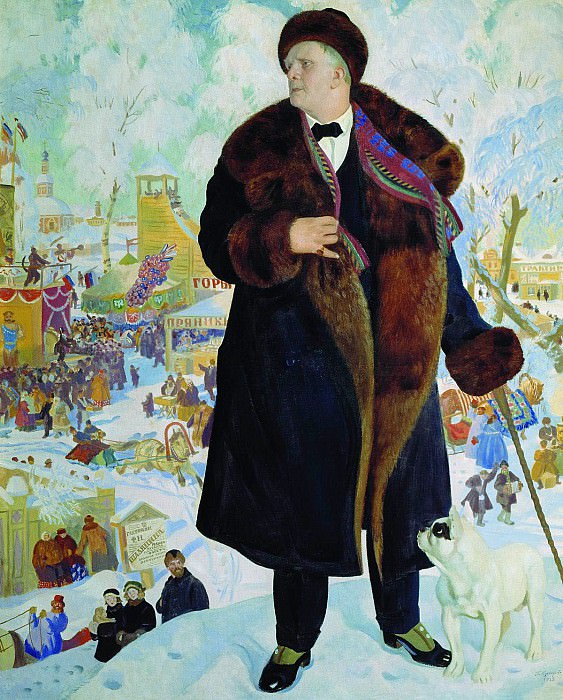Portrait of Chaliapin Boris Kustodiev (1878-1927)
Boris Kustodiev – Portrait of Chaliapin
Edit attribution
Download full size: 1200×1493 px (0,4 Mb)
Painter: Boris Kustodiev
Despite the fact that the famous portrait painter was seriously ill, he did not show, as artists - Peredvizhniki, all the hardships and deprivations of life of the people. On the contrary, winter for the artist, it is a merry sledding, farangs, carousels, festive folk festivities, brightness and colorfulness. A direct contrast to the gray and boring life. For Kustodiev Chaliapin was an idol from his youth and a friend.
Description of Boris Kustodiev’s Portrait of Chaliapin
Despite the fact that the famous portrait painter was seriously ill, he did not show, as artists - Peredvizhniki, all the hardships and deprivations of life of the people. On the contrary, winter for the artist, it is a merry sledding, farangs, carousels, festive folk festivities, brightness and colorfulness. A direct contrast to the gray and boring life. For Kustodiev Chaliapin was an idol from his youth and a friend. This is a favorite composition of the artist. The first plan of the painting is enlarged. The bottom has a large space. The long-awaited spring is just around the corner. The people have poured out into the street to welcome spring. But winter is still clinging and doesn’t want to give way. This can be seen in the snow-covered drifts. You can see a group of people having fun sledding. Stalls and fairground stalls are everywhere. And above all this fun stands the statuesque figure of Fyodor Ivanovich Chaliapin in a fur coat wide open. And next to him stands a cheerful pug. The master had to ask him to put the cat on an elevated position, so that the pug, looking at it, could "pose" for the artist. The singer as if from his height looks around the unfamiliar town where he will have to perform. The poster for his concert is at the bottom of the hill. Chaliapin walks through the streets of the town in anticipation that all the audience will appreciate his talent. The artist allowed himself a share of slyness and showed the narcissism of the famous singer. The character is dressed in an open coat, even though it’s still freezing outside. We can see that his clothes are made of beaver fur. Chaliapin has an expensive ring on his little finger. He is wearing suede boots, it is clear at once that it is not in the weather. And the singer has to lean on a cane made of valuable wood to avoid slipping and falling on the slippery road. In the background of the picture you can see the daughters of Fyodor Chaliapin: Marina and Marfa, and his friend and secretary Dvorishchin. The artist performed this painting twice in 1921 and 1922.
Кому понравилось
Пожалуйста, подождите
На эту операцию может потребоваться несколько секунд.
Информация появится в новом окне,
если открытие новых окон не запрещено в настройках вашего браузера.
You need to login
Для работы с коллекциями – пожалуйста, войдите в аккаунт (open in new window).




















COMMENTS: 2 Ответы
великолепно!
у наших художников мало сексульных картин
You cannot comment Why?
The background is a bustling scene of a Russian Masyelenitsa (Shrovetide) celebration. There are wooden stalls adorned with colorful decorations, offering goods and entertainment. People are engaged in various activities: some are playing games, others are riding in a horse-drawn sleigh, and a crowd is gathered around fairground attractions. The atmosphere is festive and vibrant, with a sense of merriment and tradition.
A white bulldog stands by Chaliapins side, looking up at him, adding a touch of domesticity and loyalty to the portrait. The artist has captured the essence of the season with the snow-covered landscape and the rosy cheeks of the figures, conveying the warmth and energy of the celebration despite the cold.
The subtexts of the painting are multi-layered. Primarily, it is a portrait that celebrates the status and charisma of Chaliapin, portraying him as a prominent figure amidst a quintessential Russian cultural event. The opulent attire and his commanding presence suggest his fame and success. Furthermore, the painting is a vibrant snapshot of Russian folk culture and tradition, harkening back to a specific time and place. The juxtaposition of the distinguished singer with the lively, common spectacle of the fair could suggest Chaliapins connection to the people and his roots in Russian culture, or perhaps his role as a cultural icon embodying the spirit of his nation. The painting can be seen as an ode to both the individual and the collective, presenting a powerful individual within a rich tapestry of communal celebration.